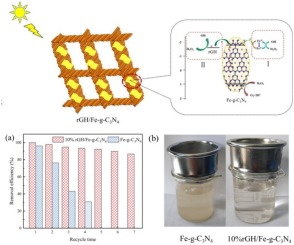当前位置:
X-MOL 学术
›
J. Ind. Eng. Chem.
›
论文详情
Our official English website, www.x-mol.net, welcomes your
feedback! (Note: you will need to create a separate account there.)
High-efficiency removal of phenol and coking wastewater via Photocatalysis-Fenton synergy over a Fe-g-C3N4 graphene hydrogel 3D structure
Journal of Industrial and Engineering Chemistry ( IF 5.9 ) Pub Date : 2020-04-01 , DOI: 10.1016/j.jiec.2020.01.012 Jinshan Hu , Pengfei Zhang , Jifang Cui , Weijia An , Li Liu , Yinghua Liang , Qingbin Yang , Hongjun Yang , Wenquan Cui
Journal of Industrial and Engineering Chemistry ( IF 5.9 ) Pub Date : 2020-04-01 , DOI: 10.1016/j.jiec.2020.01.012 Jinshan Hu , Pengfei Zhang , Jifang Cui , Weijia An , Li Liu , Yinghua Liang , Qingbin Yang , Hongjun Yang , Wenquan Cui

|
Abstract To achieve rapid separation of electron-hole pairs and improve photocatalytic degradation activity, the Fe-g-C3N4 reduced graphene hydrogel (rGH/Fe-g-C3N4) with a 3D network structure was fabricated via the hydrothermal method. Using visible light irradiation, H2O2 was added to form a photocatalysis-Fenton synergy system. The results showed that the synergistic degradation rate constant of 10% rGH/Fe-g-C3N4 was 52% higher than that of the multiphase Fenton reaction and 1.5 times higher than that of the Fe-g-C3N4. In the seventh cycle, the catalytic efficiency was still as high as 86.9%. Based on the optimized conditions from phenol degradation, the system was further applied to coking wastewater treatment, and the degradation efficiency of TOC and COD in 60 min reached 66.3% and 68.1%, respectively. Such high and stable degradation performance was ascribed to the synergy effect of photocatalysis and Fenton. Because of the photogenerated electrons not only can promote the Fe3+/Fe2+ cycle, accelerate the decomposition of H2O2, but also can quickly transfer to graphene and directly decompose H2O2 to form ·OH. Thus, a large amount of ·OH were generated through the two different channels, which greatly improve the degradation efficiency. Furthermore, rGH/Fe-g-C3N4 can be regenerated using filters without the need for additional complicated processing. This work provides an effective strategy for the deep treatment of industrial wastewater.
中文翻译:

Fe-g-C3N4石墨烯水凝胶3D结构光催化-芬顿协同高效去除苯酚和焦化废水
摘要 为了实现电子-空穴对的快速分离并提高光催化降解活性,采用水热法制备了具有3D网络结构的Fe-g-C3N4还原石墨烯水凝胶(rGH/Fe-g-C3N4)。利用可见光照射,加入H2O2形成光催化-Fenton协同体系。结果表明,10% rGH/Fe-g-C3N4的协同降解速率常数比多相Fenton反应提高52%,比Fe-g-C3N4提高1.5倍。在第七个循环中,催化效率仍然高达86.9%。在优化苯酚降解条件的基础上,将该系统进一步应用于焦化废水处理,60 min内TOC和COD的降解率分别达到66.3%和68.1%。如此高且稳定的降解性能归功于光催化和芬顿的协同作用。由于光生电子不仅可以促进Fe3+/Fe2+循环,加速H2O2的分解,而且可以快速转移到石墨烯上,直接将H2O2分解形成·OH。因此,通过两个不同的通道产生了大量的·OH,大大提高了降解效率。此外,rGH/Fe-g-C3N4 可以使用过滤器再生,无需额外的复杂处理。这项工作为工业废水的深度处理提供了一种有效的策略。还能快速转移到石墨烯上,直接分解H2O2生成·OH。因此,通过两个不同的通道产生了大量的·OH,大大提高了降解效率。此外,rGH/Fe-g-C3N4 可以使用过滤器再生,无需额外的复杂处理。这项工作为工业废水的深度处理提供了一种有效的策略。还能快速转移到石墨烯上,直接分解H2O2生成·OH。因此,通过两个不同的通道产生了大量的·OH,大大提高了降解效率。此外,rGH/Fe-g-C3N4 可以使用过滤器再生,无需额外的复杂处理。这项工作为工业废水的深度处理提供了一种有效的策略。
更新日期:2020-04-01
中文翻译:

Fe-g-C3N4石墨烯水凝胶3D结构光催化-芬顿协同高效去除苯酚和焦化废水
摘要 为了实现电子-空穴对的快速分离并提高光催化降解活性,采用水热法制备了具有3D网络结构的Fe-g-C3N4还原石墨烯水凝胶(rGH/Fe-g-C3N4)。利用可见光照射,加入H2O2形成光催化-Fenton协同体系。结果表明,10% rGH/Fe-g-C3N4的协同降解速率常数比多相Fenton反应提高52%,比Fe-g-C3N4提高1.5倍。在第七个循环中,催化效率仍然高达86.9%。在优化苯酚降解条件的基础上,将该系统进一步应用于焦化废水处理,60 min内TOC和COD的降解率分别达到66.3%和68.1%。如此高且稳定的降解性能归功于光催化和芬顿的协同作用。由于光生电子不仅可以促进Fe3+/Fe2+循环,加速H2O2的分解,而且可以快速转移到石墨烯上,直接将H2O2分解形成·OH。因此,通过两个不同的通道产生了大量的·OH,大大提高了降解效率。此外,rGH/Fe-g-C3N4 可以使用过滤器再生,无需额外的复杂处理。这项工作为工业废水的深度处理提供了一种有效的策略。还能快速转移到石墨烯上,直接分解H2O2生成·OH。因此,通过两个不同的通道产生了大量的·OH,大大提高了降解效率。此外,rGH/Fe-g-C3N4 可以使用过滤器再生,无需额外的复杂处理。这项工作为工业废水的深度处理提供了一种有效的策略。还能快速转移到石墨烯上,直接分解H2O2生成·OH。因此,通过两个不同的通道产生了大量的·OH,大大提高了降解效率。此外,rGH/Fe-g-C3N4 可以使用过滤器再生,无需额外的复杂处理。这项工作为工业废水的深度处理提供了一种有效的策略。











































 京公网安备 11010802027423号
京公网安备 11010802027423号